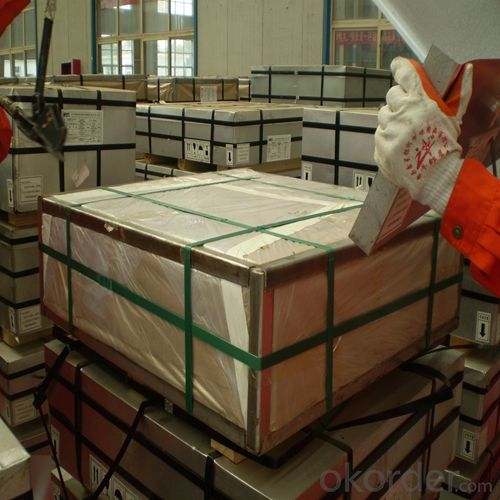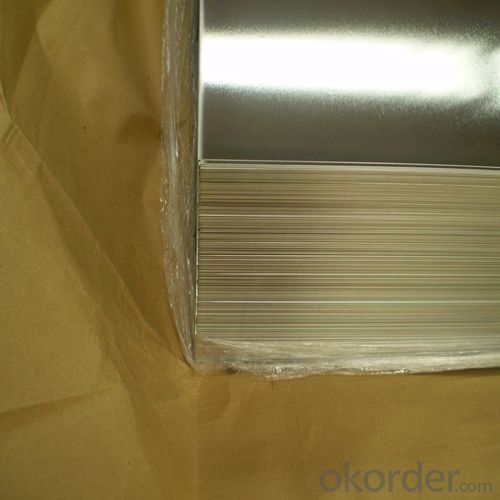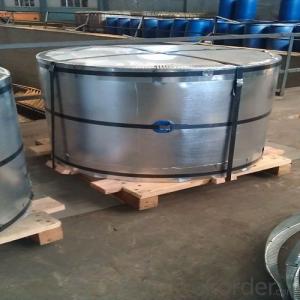Electrolytic Tinplate and TFS for Chemical Use 0.32mm Thickness
- Loading Port:
- Shanghai
- Payment Terms:
- TT OR LC
- Min Order Qty:
- 25 m.t.
- Supply Capability:
- 30000 m.t./month
OKorder Service Pledge
OKorder Financial Service
You Might Also Like
Item specifice
1.Structure of Electrolytic Tinplate and TFS for Chemical Use 0.32mm Thickness Description
Electrolytic Tinplate, is one thin steel sheet with a coating of tin applied by electrolytic deposition. Tinplate made by this process is essentially a sandwich in which the central core is strip steel. This core is cleaned in a pickling solution and then fed through tanks containing electrolyte, where tin is deposited on both sides. As the strip passes between high-frequency electric induction coils, it is heated so that the tin coating melts and flows to form a lustrous coat.
2.Main Features of the Electrolytic Tinplate and TFS for Chemical Use 0.32mm Thickness
Paintability and printability – Tinplates have excellent paintability and printability. Printing is beautifully finished using various lacquers and inks.
Corrosion resistance – Tinplate has got good corrosion resistance. By selecting a proper coating weight, appropriate corrosion resistance is obtained against container contents. Coated items should meet 24 hour 5 % salt spray requirement.
Solderability and weldability – Tinplates can be joined both by soldering or welding. These properties of tinplate are used for making various types of cans.
Safe – Tinplate being low weight and high strength makes food cans easy to ship and transport.
Eco friendly – Tinplate offers 100 % recyclability.
Tin is not good for low temperature applications since it changes structure and loses adhesion when exposed to temperatures below – 40 deg C.
3.Electrolytic Tinplate and TFS for Chemical Use 0.32mm Thickness Images



4.Electrolytic Tinplate and TFS for Chemical Use 0.32mm Thickness Specification
Specification of :
Standard: ISO 11949 -1995, GB/T2520-2000,JIS G3303,ASTM A623, BS EN 10202
Material: MR,SPCC
Thickness:0.15mm - 0.50mm
Width: 600mm -1150mm
Temper: T1-T5
Annealing: BA & CA
Coil Inner Diameter: 508mm
Weight: 6-10 tons/coil 1~1.7 tons/sheets bundle
Passivation:311
Oil: DOS
Surface: Finish,bright,stone,matte,silver
5.FAQ of Electrolytic Tinplate and TFS for Chemical Use 0.32mm Thickness
- How are the tinplates specified?
The tinplates are specified as per the steel base, extent of tempering, the coating weight, annealing method and the surface finish.
- How many types there are for base steels?
The base steels are of three types: Type MR, L, D
- Q:Tinned iron and iron matte tin in difference
- While in tinplate iron or iron matte silver, the surface is sandy, so people often referred to as silver iron, its price is a tin material price is more expensive, generally can usually used without printing packing, for printed cans is usually to is sandy, it is generally. Iron printing, matte iron tensile and hardness of tin iron generally not good, some specifications of tinplate is not suitable for stretching relatively large.
- Q:How does tinplate impact the overall product design?
- Tinplate impacts the overall product design by providing a versatile and durable material that can be easily shaped and formed into various designs. Its corrosion resistance properties make it suitable for packaging applications, ensuring the product's integrity and prolonging its shelf life. Additionally, tinplate's aesthetic appeal and ability to be printed on enables creative branding opportunities, enhancing the product's visual appeal and marketability.
- Q:What are the different ways to recycle tinplate containers?
- There are several different ways to recycle tinplate containers. One common method is to separate the tinplate from any other materials, such as plastic or paper, and then melt it down to create new tinplate products. Another option is to crush or shred the containers into small pieces, known as scrap, which can then be used as raw material for manufacturing new products. Additionally, recycling facilities may also use advanced technologies to separate the tinplate from any coatings or contaminants before recycling it.
- Q:Can tinplate be used for art and sculptures?
- Yes, tinplate can be used for art and sculptures. Its malleability, durability, and ability to hold intricate details make it a popular choice for creating various artistic forms. Additionally, tinplate can be easily manipulated, painted, and polished, allowing artists to explore different techniques and finishes in their creations.
- Q:Soup with tin cans loaded also need high temperature sterilization?
- If you are a start-up factory, you need to save money, you can choose a small sterilization pot, covering an area of small, heat source is also very good solution.
- Q:What are the main applications of tinplate in the chemical industry?
- Tinplate is widely used in the chemical industry for various applications such as packaging, storage, and transportation of chemicals. Its corrosion resistance properties make it an ideal choice for containers, cans, and drums used to store chemicals. Tinplate also provides a barrier against moisture and oxygen, which helps in preserving the quality and integrity of chemical products. Additionally, tinplate is used for the production of aerosol cans, chemical spray bottles, and other packaging solutions, ensuring safe and efficient handling of chemicals in the industry.
- Q:How is tinplate decorated or printed?
- Tinplate is commonly decorated or printed using various methods such as lithography, offset printing, and silk-screen printing. These techniques allow for intricate designs, patterns, and colors to be applied onto the tinplate surface, resulting in visually appealing and customized products.
- Q:What are the main applications of tinplate in the construction industry?
- Tinplate is commonly used in the construction industry for the production of roofing materials, such as tin roofs, due to its durability, corrosion resistance, and ability to withstand extreme weather conditions. It is also utilized for manufacturing gutters, downspouts, and flashings, providing protection against water damage. Additionally, tinplate is employed in the construction of HVAC systems, air ducts, and ventilation pipes, as it provides a reliable barrier against moisture and corrosion.
- Q:Can tinplate be recycled?
- Yes, tinplate can be recycled. It is a highly recyclable material that can be melted down and reused to make new tinplate products. Recycling tinplate helps to reduce waste and conserve resources.
- Q:How does tinplate packaging contribute to product protection against leakage?
- Tinplate packaging contributes to product protection against leakage primarily due to its durable and corrosion-resistant properties. The tin coating on the steel substrate prevents any contact between the product and the surrounding environment, minimizing the risk of leakage. Additionally, tinplate packaging is often manufactured using advanced sealing techniques, ensuring airtight and leak-proof closures. Overall, the robust nature of tinplate packaging serves as a reliable barrier, safeguarding the product from potential leakage and preserving its quality.
1. Manufacturer Overview |
|
|---|---|
| Location | |
| Year Established | |
| Annual Output Value | |
| Main Markets | |
| Company Certifications | |
2. Manufacturer Certificates |
|
|---|---|
| a) Certification Name | |
| Range | |
| Reference | |
| Validity Period | |
3. Manufacturer Capability |
|
|---|---|
| a)Trade Capacity | |
| Nearest Port | |
| Export Percentage | |
| No.of Employees in Trade Department | |
| Language Spoken: | |
| b)Factory Information | |
| Factory Size: | |
| No. of Production Lines | |
| Contract Manufacturing | |
| Product Price Range | |
Send your message to us
Electrolytic Tinplate and TFS for Chemical Use 0.32mm Thickness
- Loading Port:
- Shanghai
- Payment Terms:
- TT OR LC
- Min Order Qty:
- 25 m.t.
- Supply Capability:
- 30000 m.t./month
OKorder Service Pledge
OKorder Financial Service
Similar products
New products
Hot products
Related keywords

























